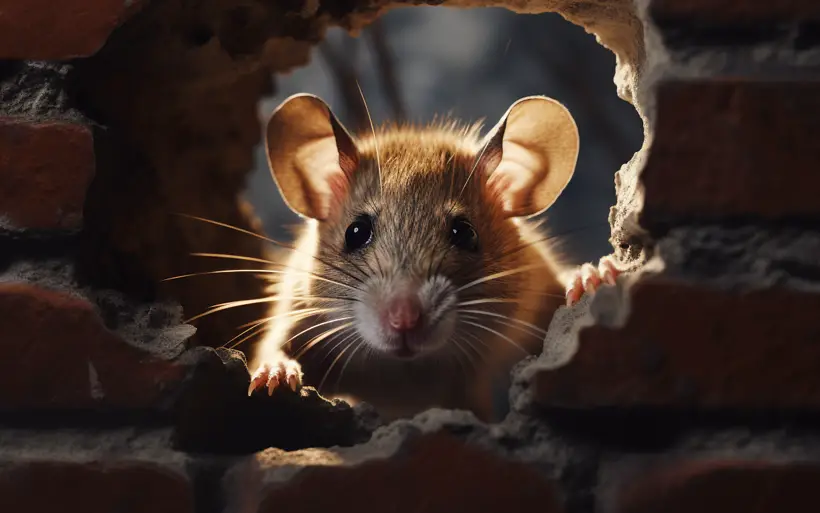How To Get Rid Of Mice In The Wall? Answer You Have Been Looking For!
Dealing with the hidden presence of mice within your home can be a difficult and daunting task. The subtle sounds of tiny paws scampering through hidden passageways and the pungent scent of their excretion can cause discomfort and unease.
So, how do you get rid of mice in the wall? Place traps along walls and near nesting areas, baited with peanut butter or dried fruit. Check and reset traps regularly until the infestation is gone. Seal all entry points to prevent new mice from entering. Maintain a clean environment and trim vegetation near the house.
Continue reading this guide to learn how to combat the mice infestation plaguing your walls. Discover the entry points mice exploit to infiltrate your home and how to prevent future invasions.
Signs There Are Mice In Your Walls

Here are the signs to be on the lookout for mice at your home.
- Scratching and scurrying noises: These noises are typically more noticeable during the night when mice are most active and seeking food.
- Droppings: Mouse droppings are small, dark, and pellet-like, resembling rice grains. You may find them scattered along baseboards, in corners, behind furniture, and near nesting areas.
- Gnaw marks: You might find gnaw marks on various objects like electrical wires, wood, plastic, and even food packaging. The presence of fresh gnaw marks indicates an active infestation.
- Foul odor: Mice have a distinct musky smell that becomes more pronounced as their population grows. If you notice an unpleasant odor in specific areas of your home, especially close to walls, it could be a sign of a nearby mouse nest.
- Grease marks: As mice move along walls, they leave greasy marks on their fur and bodies, especially in areas with regular traffic. These marks can be visible on walls and baseboards and are an additional sign of their activity.
How To Get Rid Of Mice In Your Walls?
If you already have your house infested by mice, the first step is to get rid of them. Here’s an in-depth guide on how to effectively eliminate mice infestations and ensure they don’t return:

Strategically Place Traps:
Set up traps along walls, baseboards, and near nesting areas. Both snap traps and live traps are effective options. Use peanut butter, chocolate, or dried fruit as bait. Placing traps perpendicular to walls with the trigger end towards the wall can increase their effectiveness.
Monitor and Remove Trapped Mice:
Check the traps frequently, especially in the initial stages of trapping. If using live traps, release the captured mice far away from your home. For snap traps, handle mouse carcasses with care, wear gloves, and dispose of them properly. Dead mice may deter other mice from using the same route, thus rendering the trap ineffective.
Sanitize Infested Areas:
After successfully removing mice, thoroughly clean and sanitize the affected areas to eliminate any lingering odors that could attract new mice. Use a mixture of bleach and water to disinfect surfaces, especially near nesting sites.
How Do Mice Get In Your Walls?
Now I believe you have got rid of the mice from your house. But what if they come again? It can happen if you don’t address how they get into your house.
Mice are remarkably agile and resourceful creatures, capable of squeezing through tiny openings to find shelter and food within the walls of your home.

Examples of these openings include:
- Gaps and cracks: Mice can slip through openings as small as a quarter-inch in diameter. Any unsealed opening becomes an inviting pathway for these rodents.
- Chimneys and roof access: Mice are excellent climbers and can access your walls through chimneys or gaps in the roofline. They can navigate along tree branches or trellises to gain entry to the upper levels of your home, where they may eventually find their way into the walls.
- Vents and utility openings: Exterior vents, such as dryer vents and bathroom exhaust vents, may have large openings that mice can enter. Additionally, utility openings, like gaps around electrical, cable, and plumbing lines, provide an entry point for these nimble rodents.
- Foundation and siding gaps: Inspect the foundation and siding of your home for any gaps or cracks. Mice can easily slip through damaged areas or find weak points to chew their way in.
- Garage and attic access: Mice can find their way into your walls through access points in the garage or attic, especially if these areas are not adequately sealed or have gaps in their structures.
What Attracts Mice To Your House?
Mice are resourceful creatures that are drawn to a variety of factors in and around your home. You must address the reasons why mice get into your house.

The attracting factors that attract mice are as follows.
- Food Sources: Crumbs, spilled food, open food containers, and improperly stored pantry items provide mice with a readily available food supply. Pet food left out overnight can also be enticing to mice.
- Water: Like all living beings, mice require water to survive. Leaky pipes, dripping faucets, and standing water in dishes can be a significant draw for mice. They can often find water sources in kitchens, bathrooms, basements, and crawl spaces.
- Warmth and Shelter: During colder months, mice seek warm and sheltered environments to nest and stay protected. Your home’s walls, attic, crawl spaces, and cluttered storage areas offer ideal nesting sites.
- Easy Entry Points: Mice can exploit even the tiniest openings to gain access to your home. Gaps around doors, utility lines, and damaged siding or roofing can provide entry points for mice.
- Clutter and Hiding Spots: Poorly organized areas create perfect hiding spots for mice, allowing them to feel secure while foraging for food.
- Overgrown Vegetation: Trees, shrubs, and bushes growing close to your home can serve as bridges for mice to climb and gain entry through openings in the roof or walls. These vegetation-covered areas also provide hiding spots for mice.
- Unattended Garbage: Garbage cans with improperly sealed lids or those left unattended can be an easy source of food for mice.
Preventative Measures to Keep Mice Away from Your House:
Now you know why and how mice get into your house. So, it’s time to prevent them by addressing the reasons behind mice infestation. To prevent future infestations, adopt the proactive measures below:
- Maintain a clean environment: Regularly clean up food crumbs, spills, and food debris. Store food in airtight containers to deny mice easy access to food sources.
- Seal entry points: Inspect your home thoroughly for any gaps, cracks, or holes in walls, doors, and windows. Use fast-drying cement, steel wool, caulk, or spray foam to seal cracks and gaps.

In addition, use wire mesh to seal vents and chimney caps for chimney outlets. Finally, repair damaged weather stripping for your windows.
- Remove clutter: Declutter your living spaces to eliminate hiding spots for mice. Keep storage areas tidy and organized.
- Landscaping: Trim bushes and tree branches away from your home’s exterior to minimize potential access points for mice.
- Proper waste management: Use tightly sealed garbage cans and place them away from the house to prevent attracting mice with food waste.
- Using natural deterrents: If you prefer eco-friendly and humane methods, you can use peppermint or clove oil, mothballs, get a cat, or ultrasonic devices.
What Happens If You Don’t Address A Mice Problem?
Failure to address a mouse problem can result in a cascade of negative consequences that affect both your health and your home. The consequences are as follows.

Spread of Diseases
Mice are carriers of a wide range of pathogens and bacteria that can cause serious health problems in humans. They can spread diseases like Hantavirus, Salmonella, Leptospirosis, and Lymphocytic Choriomeningitis (LCMV) through their droppings, urine, and saliva.
Exposure to these contaminants can result in respiratory issues, flu-like symptoms, and even life-threatening conditions.
Structural Damage
Mice are notorious chewers, and their constant gnawing can cause significant damage to your home’s infrastructure. They attack electrical wires, insulation, wood, and even plastic pipes.
Electrical wires that have been chewed pose a serious fire risk, and compromised insulation can result in higher energy costs. The structural integrity of wooden beams and supports can also be compromised, resulting in costly repairs.

Uncontrolled Reproduction
Each female mouse is capable of producing multiple litters per year. Each litter consists of up to 10 babies. Ignoring the problem allows the mouse population to multiply rapidly, exacerbating the infestation and making eradication more difficult and time-consuming.
Contamination of Food and Surfaces
Mice are highly skilled at infiltrating kitchens and pantries, contaminating stored food with their droppings, urine, and fur. Consuming contaminated food can lead to food poisoning and other health issues.
After uncovering the steps to evict mice from your walls, many homeowners consider seeking professional assistance. If you’re pondering the same, learn about how long it usually takes for an exterminator to address a mouse problem. Additionally, to further understand the resilience of these tiny creatures, explore how long a mouse can survive without food.FAQS
Here are some questions related to how to get rid of mice in the wall.
Q1. When should I call a pest control expert?
If you’ve tried and failed to get mice out of your walls, or if you’re dealing with a large infestation, it’s best to contact a professional pest control expert. They have the knowledge and experience to deal with the situation in an effective and safe manner.
Q2. What if there is a dead mouse on my wall?
If you suspect there is a dead mouse on your wall but cannot locate it, it’s essential to remove it promptly to avoid unpleasant odors. You may need to cut an access hole in the wall to remove the dead mouse. Ensure you wear gloves and dispose of the body away from the house
Q3. How often do I need to check traps?
During an active infestation, check traps daily to ensure you catch mice as soon as possible. Once the infestation is under control, you can reduce the frequency to once or twice a week.
Conclusion
When faced with indications of mice infestation within your residence, it becomes crucial to address the issue to prevent the population from growing. First, identify the signs of infestation, implement preventive measures, and adopt appropriate extermination techniques discussed in the article.
Remember that prevention is the best defense against future infestations, so maintain good housekeeping and proactively seal any potential entry points. If you are experiencing persistent problems, do not hesitate to seek the assistance of pest control professionals who can provide tailored solutions.




